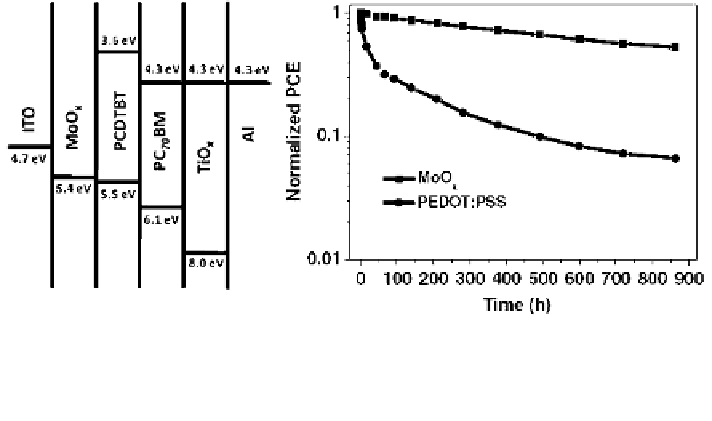Environmental Engineering Reference
In-Depth Information
hole injection into electroluminescent polymer. These devices without ITO show a
remarkably slower degradation.
Since PEDOT:PSS is a water-based solution with slight acidic nature, it is easy
to cause interface instability associated with the etching of ITO and the diffusion to
photoactive layer upon water adsorption. p-type like or transition metal oxides,
such as MoO
3
,V
2
O
5
, and WO
3
, are becoming the most promising replacement of
PEDOT:PSS as anode buffer layer to overcome the interface instability. Shrotriya
et al. demonstrated transition metal oxides MoO
3
and V
2
O
5
to replace
PEDOT:PSS, forming Ohmic contact between active layer and ITO and improving
device efficiency [
67
]. Recently, many investigations have involved transition
metal oxides to enhance the hole transport/collection and extend the lifetime of
device operation [
68
-
71
].
Sun et al. combined both benefits of anode and cathode interfacial layers MoO
x
and TiO
x
to obtain efficient and air-stable BHJ OPVs based on PCDTBT:PC
70
BM
[
72
], as shown in Fig.
6.12
(left). Figure
6.12
(right) shows the comparison of the
air stability of PCDTBT:PC
70
BM devices fabricated with a 9 nm MoO
x
and
PEDOT:PSS as a function of storage time in air under ambient conditions. The
MoO
x
based BHJ solar cells without encapsulation exhibit better air stability than
PEDOT:PSS based ones. MoO
x
based devices retain about 50 % of its original
PCE after storage in air for 720 h, on the contrary, PEDOT:PSS based devices
keep about 10 % of its original PCE after storage in air for 480 h, indicating that
the former ones (MoO
x
) have a slower degradation than the latter ones (PE-
DOT:PSS). The improvement of device stability is explained by the hygroscopic
and acidic PSS, a source of interface instability due to the diffusion of PSS to other
layers and reaction with other components. The replacement of PEDOT:PSS with
MoO
x
overcomes interface instability and yields significant improvement in air
stability.
Fig. 6.12 (left) The device structure; (right) Normalized PCEs as a function of storage time for
PCDTBT:PC
70
BM solar cells fabricated with PEDOT:PSS and MoO
x
in air under ambient
conditions
(no
encapsulation)
[
72
].
(Copyright
John
Wiley
and
Sons.
Reproduced
with
permission)

Search WWH ::

Custom Search